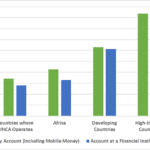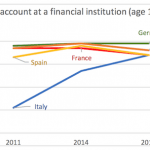The Global Findex Database Shows We Can’t Meet the SDGs Without Financial Inclusion
For nearly a decade now, I’ve led the World Bank’s Global Findex database, a survey of how people in more than 150 countries access and use financial services. In that time, I’ve seen how transformational financial services can be: They can result in women gaining greater privacy and control; more children enrolled in school; increased employment; and more nutritious food. Don’t just take my word for it: Repeatedly, rigorous academic studies are clarifying the ways in which financial inclusion underpins and allows for social progress.
To those of us who study global development, it’s becoming clear that, to eradicate poverty, achieve gender equality, provide quality education, or meet any of the United Nation’s Sustainable Development Goals (SDGs), we must begin by creating a financially inclusive world.
To do that, we first need to measure the scope and depth of the problem we’re trying to solve: Who still needs accounts? Who has accounts, but doesn’t use them? What more can we do to help?
The Findex answers those questions. With support from the Bill & Melinda Gates Foundation, the Findex assesses progress toward financial inclusion. Our research has shown that, in just a few years, more than one billion people have opened an account, giving them a foothold in the formal economy. On top of that, financial inclusion is now firmly part of the global development agenda, including the World Bank’s goal of Universal Financial Access by 2020. Moreover, access to financial services is recognized as a United Nations sustainable development target, and dozens of countries have adopted financial inclusion strategies.
That’s important progress – we shouldn’t overlook what we’ve already achieved, or how quickly we’ve achieved it. But there’s still a great deal of work ahead of us: It’s not enough to have an account. To achieve our development goals, it’s important for people to use their accounts. Findex data show that, in India, half of all accounts have never been used. We see other significant access-usage gaps around the world. Our great challenge is to design appropriate and affordable financial services that people use to meet their needs, within a well-regulated environment characterized by robust consumer protections.
The Findex helps with this, too. It identifies the gaps in account ownership and usage by gender, income, age and more to help identify solutions.
We have to address those gaps, because high-quality financial services can make a profound difference in peoples’ lives. Randomized field experiments have found that when a woman is offered a savings account, she builds savings, spends more on her children’s education and on nutritious food, and invests in business opportunities. A study in the Philippines shows that women who are offered their own commitment savings accounts report increased decision-making power, and their households are more likely to buy a washing machine and other goods that might benefit women. In Bangladesh, before a factory made the switch from cash to digital payments, women’s mothers-in-law sat outside the gate on payday, waiting for their cut; afterwards, employees had their own accounts – and more control over their money. These studies show that having an account gives women greater privacy, security and agency.
Studies are also demonstrating how financial services can help children enroll in school: An experiment that provided Kenyan families with access to a digital savings account boosted high school enrollment by about 6 percent, one-third higher than those without access to those services. In Nepal, education spending increased by 20 percent when women-headed households were given access to digital savings accounts. Putting children through school can be transformational – not just for the children themselves, but for their families and communities as well.
These services can even lead to safer, more stable societies. Digitizing entrance fees to national parks in Tanzania reduced leakages by 40 percent. In India, switching from cash to smart cards for pension payments resulted in a 47 percent reduction in reported requests for bribes from officials. In Afghanistan, police seemed to receive a 30 percent “raise” once the government switched to mobile money; in fact, they were receiving their full salaries for the first time.
The evidence is clear: Financial services enable social and economic development. They give more people a greater degree of control and certainty about their finances. They restore the time that would otherwise be wasted traveling to pay a bill. They allow us to seize opportunities, withstand shocks and live our day-to-day lives.
Those are significant advantages – ones that we take for granted. The rest of the world needs them as well. Inclusive finance means so much more to the billions of people left out of the formal financial sector and those of us striving to realize the UN’s SDGs: Financial services create the foundation we need to build a better world.
Leora Klapper is a Lead Economist in the Development Research Group at the World Bank.
Photo courtesy of Accion.
- Categories
- Finance



